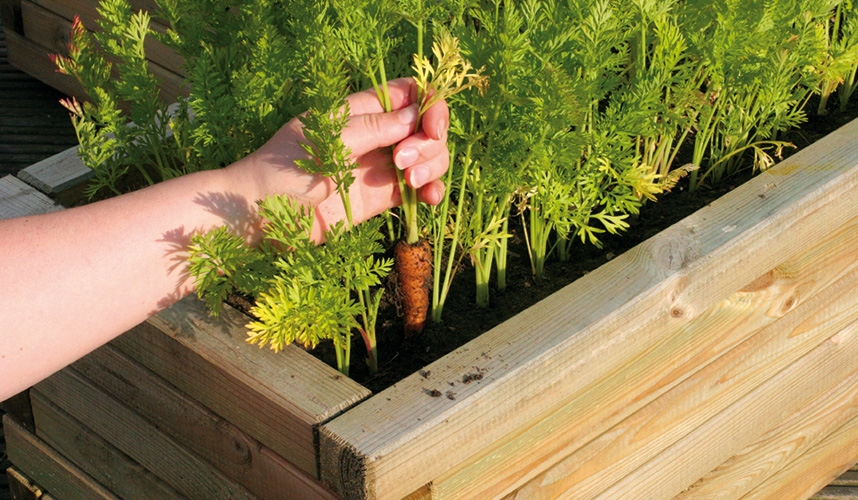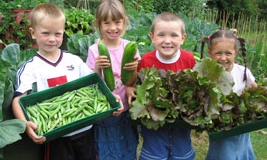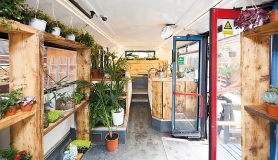Even a novice gardener can produce mouth-watering, fresh food for themselves and their family. Square Foot Gardening* allows for the planting and sowing of small quantities of young plants and seeds at frequent intervals over the growing season to produce a regular supply of produce. Its devotees claim that the method can produce five times the yield of a conventional vegetable garden, needs less watering and can be started at any time of the year. The idea is to grow a different vegetable, fruit or herb in each one foot square. This produces a tapestry of colour and texture, is ideal for small households and is a great way to encourage children to begin gardening, especially in schools. Where space is really limited there is always the vertical option, using supports and wall space, creating archways and pergolas. The technique can also be used to create herb gardens and mini-flower gardens.
Getting Started
There are two ways to start your Square Foot Garden. One is to use an existing area of bare soil and the other is to grow produce in a container. For the bare soil option select an area of weed-free soil measuring four feet by four feet. It will need to receive sunlight for at least a good part of the day. Crops are only as good as the soil in which they grow and as this is an intensive method of growing, it is important that it is in good heart to support the crops’ needs. Dig the soil to at least one spade’s depth and incorporate plenty of good quality compost (home-made is best and a gardening friend may be able to help out here) or mushroom compost. Both organic options are available at garden centres. For an area this size just use the sharp side of a hand trowel to break up any lumps of soil until the surface has a crumbly texture and is level. Using pegs and string or by laying four feet long bamboo canes, divide the square into sixteen one foot squares. Each square can be used to produce a different type of vegetable, herb or fruit.
Alternatively you can create a raised bed on the bare soil. Using four lengths of untreated timber (this will not last forever but will avoid chemical treatments leeching into the soil) each measuring four feet by six inches, fix together a square frame, screwing a small block of wood into each corner to keep the frame rigid. Lay it level on the surface of the soil, fill with compost and divide the space up as before. Another option is to grow produce in a four feet square container with adequate drainage holes.
If you are a gardener with a disability or are simply not the DIY type, then there are purpose built systems available. One of the best is made and sold by Link-A-Bord (www.link-a-bord.com tel: 01773 590566) who offer an affordable range of planting options for raised gardens. Link-A-Bord’s products are made from recycled plastic, are non-toxic, will not fade, rot or require painting, are easy to construct and come in several colours. The system consists of a collection of rigid plastic boards, links and dowels that can be used to build raised beds to your own requirements. They also have a unique double-skin construction. This keeps out the cold in bad weather but also keeps the roots cool in summer, preventing the plants from drying out. The design allows for water to drain and importantly, for air to circulate properly. If you plan to grow deep rooted vegetables such as carrots or parsnips in containers you will need a depth of soil or compost of at least twelve inches.
By restricting the width of the bed to four feet it can be tended from each side without the need to tread on the soil. The soil structure will remain open and the bed need not be dug over again. You can, of course, make the bed into a rectangle by linking one or more four feet squares, providing it remains just four feet wide. The principle is the same for either, to grow a succession of different crops in one foot squares; rotating different crops to prevent the build up of pests and diseases.
As there are no spaces between the rows crops can be grown more intensively and few weeds get a chance to grow.
Crop Protection
Unfortunately, the Square Foot Garden is no different to any other when it comes to the need to protect against garden pests. Young plants can be covered with mini-cloches made from plastic drink bottles with the bottoms cut off. Slugs love beer and can be fatally attracted to beer traps (used margarine tubs or yoghurt pots sunk into the ground with the tops a fraction above ground level and filled with beer). Snails and caterpillars can be picked off by hand and netting will keep cats and birds off the crops. Growing strong smelling herbs and flowers such as nasturtiums, marigolds, thyme and the poached egg plant (limnanthes) amongst the vegetables will help deter whitefly and greenfly and attract ladybirds and hoverflies to make a quick lunch of any that remain.
Growing your own food is one of the most satisfying of activities. It exercises the body and soothes the mind, puts you in touch with nature and makes you slow down for a while. Good gardening is about observation and because a garden is constantly changing we are always learning something new. Climate change means that we will have to start using even more of our observational skills and adapt our gardening to meet the challenge. Living a healthier life can begin with growing your own food in your own small space - even if it is just one foot square.
What To Grow
Having created your Square Foot Garden you can embark on the fun (or dilemma) of deciding just what to grow. Obviously this will be guided mainly by your eating preferences but there will be practical considerations. Potatoes grow spread out underground and need a lot of space so would be impractical in the Square Foot Garden, although these can be grown very successfully in large pots or other containers with good drainage. Squashes can scramble along the ground for several metres but one plant could be included in the planting plan by being grown up a vertical support. Peas can be supported by twiggy sticks.
When choosing what to grow and where within the square, consider how it will look. Rhubarb chard with its rich red coloured stems looks stunning beside the dark green ‘blistered’ leaves of Black Tuscany kale or tall, elegant sweetcorn. Sweet peas climbing together with peas and beans look colourful as well as attracting bees for pollination purposes. Parsley and strawberries, especially small alpine strawberries, make attractive edging and nasturtiums and pot marigolds provide both colour and edible flowers, petals and seeds. Organically produced seed is easy to find but young vegetable plants may not be. If you do not have an organic gardener friend who can share their plants with you then try your local farmers’ market. Most of them have a plant stall selling organically raised plants. Miniature vegetables can also be grown from seed to produce fully mature specimens that are perfect for single portions or for children to grow.
Some plants grow particularly well when planted close to each other while others seem to be less favourably matched (companion planting). The following planting guide is designed with this broad principle in mind.
1. French climbing beans x4 2. Runner beans x 4 3. Sugar snap peas 4. Sweetcorn 5. Lettuces 6. Carrots or leeks 7. Broccoli 8. Squash 9. Courgettes 10. Tomatoes and marigolds 11. Onions and spring onions 12. Chard and/or beetroot 13. Spinach and strawberries 14. Cherry tomatoes and nasturtiums 15. Mixed herbs 16. Spring cabbages
Seed Suppliers
The Organic Gardening Catalogue www.OrganicCatalogue.com 0845 130 1304
Seeds of Italy www.seedsofitaly.com 02089302516
This article was first published in The Green Parent Issue 13. To read content from all our back issues subscribe to our digital editions and get full access to our archive.







